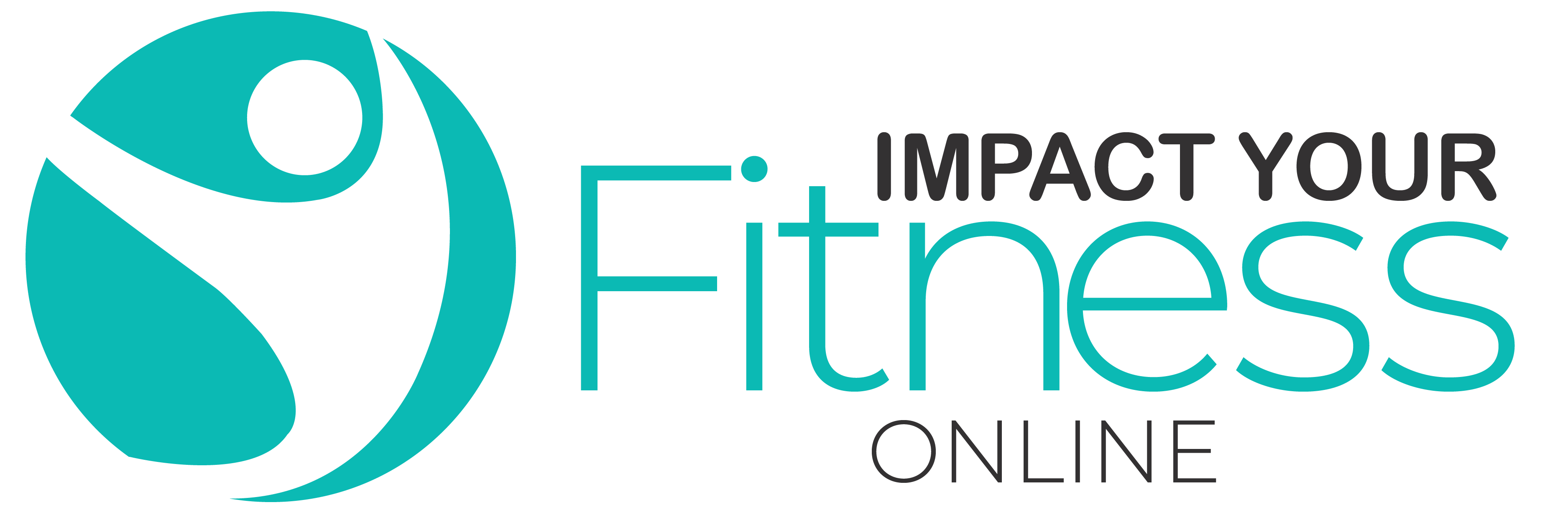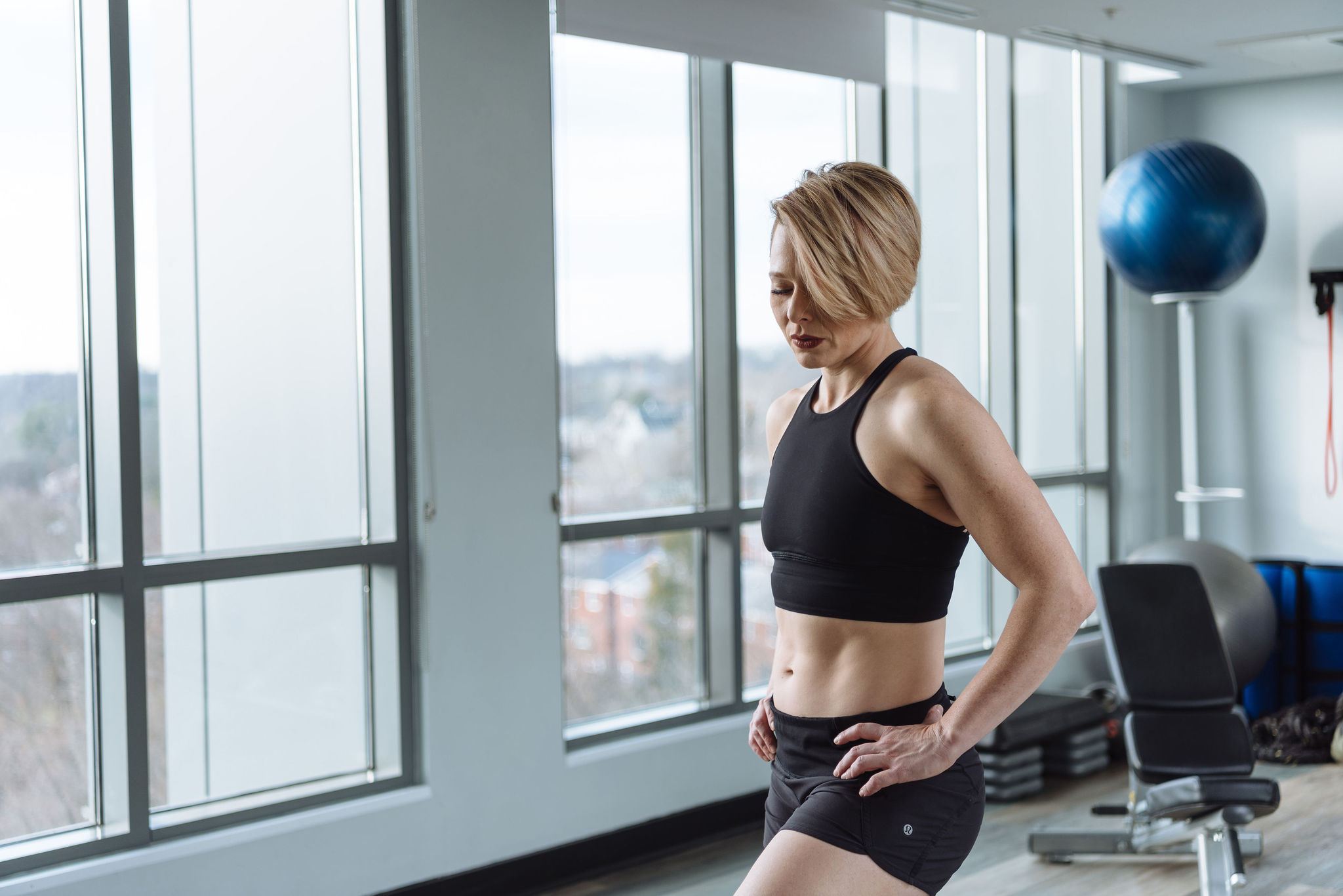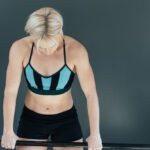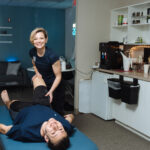There is a difference between exercises to move your body and exercises to stimulate your body, mind, muscles, and flexibility simultaneously.
Jenn Schwartz
They may even look the same but the difference is something I can teach you to use at home.
I know personally, (and for many of you) bodyweight exercises are not enough to keep our bodies strong. You have been stimulating your body with exercise and that made it incredibly strong to overcome what you’ve overcome. To keep your body strong, you have to keep stimulating it.
There are endless opportunities to change the resistance and increase the challenge of bodyweight exercises without adding traditional equipment. Discerning what is adding value and what not helpful. Learning the practice of using resistance intelligently is the purpose of this article.
We can use a combination of isometric holds, adding friction, band tension, and/or lifting the heels for bodyweight lunges and squats.
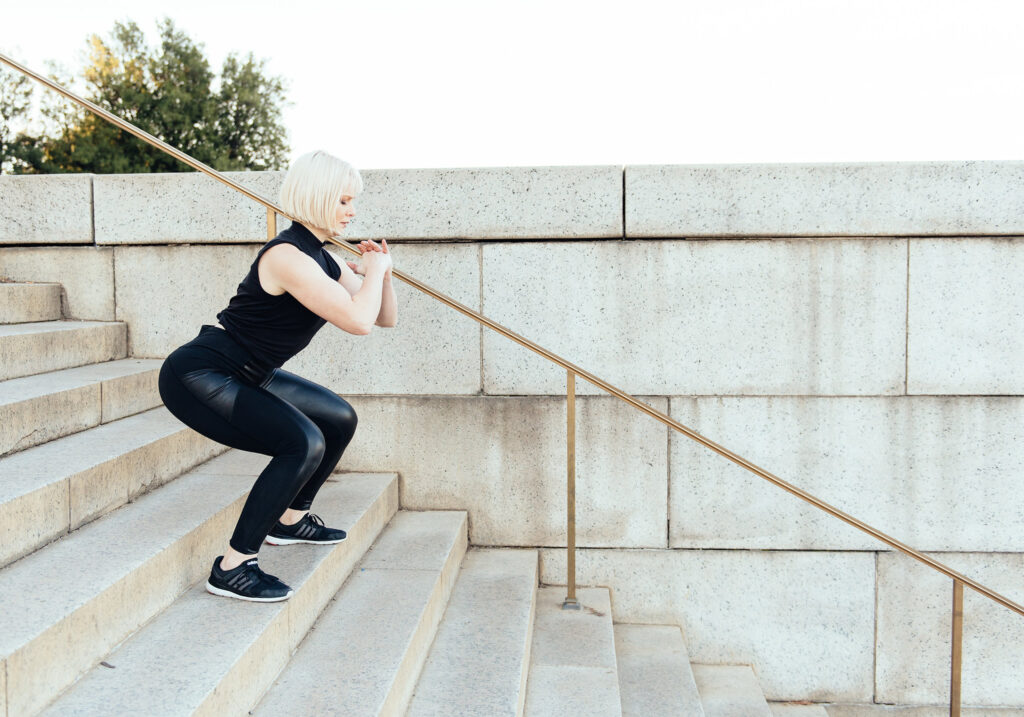
Strategy 1: Using isometrics
Isometrics not only add burn-factor to your routine but can re-engage muscles that are weakened. Imagine that your minimalist exercise can also be something that helps old injuries AND increases range of motion?
That’s a beautiful thing.
Isometrics can be described as purposely holding tension in the muscles while holding positions. There’s also a learning aspect to them that can impact every inch of your performance in exercise.
Here’s what the research shows on isometrics, direct download
Here’s an example of isometric exercise in action: Instagram Video
This highly underrated and underutilized type of exercise is in every one of my client’s programs. I’ve been using them in my own programming for 10 years. They keep my exercise effective, safe, and challenging. I use them around my knees to ensure that they remain pain-free with balanced muscles. I use them before my exercise for a tuned-in warm-up and during my strength training to experience very connected and engaging exercises.
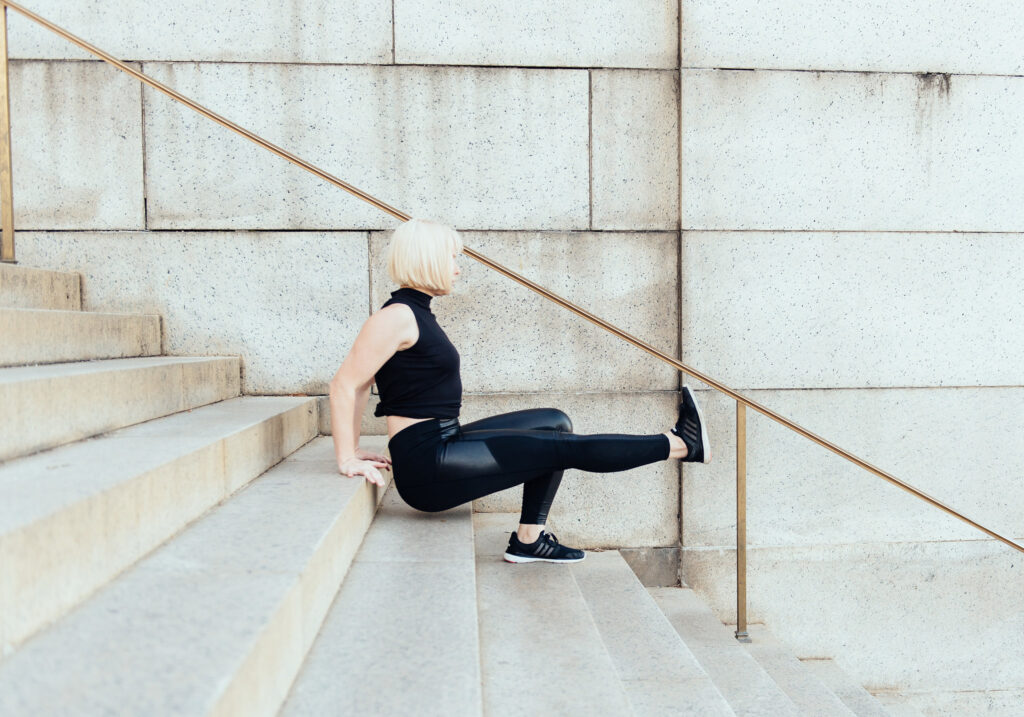
Strategy 2: Using physics to enhance your exercise
Typical home workout content is based on HIIT. Not all workouts are supposed to be like Orangetheory. If you want to get stronger, build a physique, keep your quickness, strengthen your immune system, or help your joints be healthy, strength training is essential and it can be done at home.
Educating the general public on the exponential benefits of strength training is difficult when so many have been conditioned to believe their exercise has to hurt and that they have something to prove. However, the most effective exercises are simplistic and sophisticated in design and it has nothing to do with how much it hurts. When I say that I realize how I sound, an exercise snob that’s out of touch. It’s not that at all, it’s exercise skinned down to the fundamentals. Knowing these fundamentals is using basic high school physics and this can be applied to any type of exercise that will be inspired to work better for you.
When I said that there are endless opportunities for variations for home exercise I want to say that my entire view on exercise changed when I began studying physics, mechanics, and the physical world of movement. This helped me shift to the trainer and specialist that I am now. This perspective helped me find more purpose in my exercise and continues to impact the dozens of client-based decisions I make every day.
There are different ways that we can apply physics to upgrade our home workouts.
Adding tension to the movement: this can be a moving or non-moving push within the bodyweight exercise
Adding tension to the exercise, it comes from the inside! Think about being able to feel your muscles working and getting immediate feedback. The problem with many bodyweight exercises is that they offer so little resistance and therefore little opportunity to stimulate the muscles. Muscles need just the right amount of stimulus to get stronger, to achieve the sexier, or improve the health of your joints.
Contrary to popular belief, the tension in our muscles is a good thing! It is the contractile pull that enables us to be upright and moving in a gravity-based world. So, to upgrade your exercise, you need to understand that notion.
Adding tension means the addition of emphasis on angles to increase the demand of the exercise. This equates to being able to control the amount of muscle tension you are putting out and therefore adding to the exercise without adding a new piece of equipment.
This practice can also give an external focus point of control because you are pushing against something with a directional opposing force. Just thinking about that direction while performing it will bring you a more favorable outcome versus listening to music, counting, or thinking about squeezing your muscles.
Here’s an example of adding external tension to emphasize a different part of the basic plank: Instagram video
Adding Friction
Friction is a force that opposes motion. So an external force can create tension in the muscles to overcome the opposition. This happens when we use a slider or towel underneath our foot during a lunge.
It’s a fabulous addition to upper body exercises. When adding a little bit of friction (just a push into an opposing direction) through the handles you will get an increase in muscle activity and the motion becomes a fuller challenge throughout, which fights the mediocrity of bodyweight exercises only offering a challenge in 10% of the movement.
Here’s an example of adding friction and tension to an exercise: Instagram Video
The first exercise is adding friction to the moving leg. My foot is pushing and pulling into the ground.
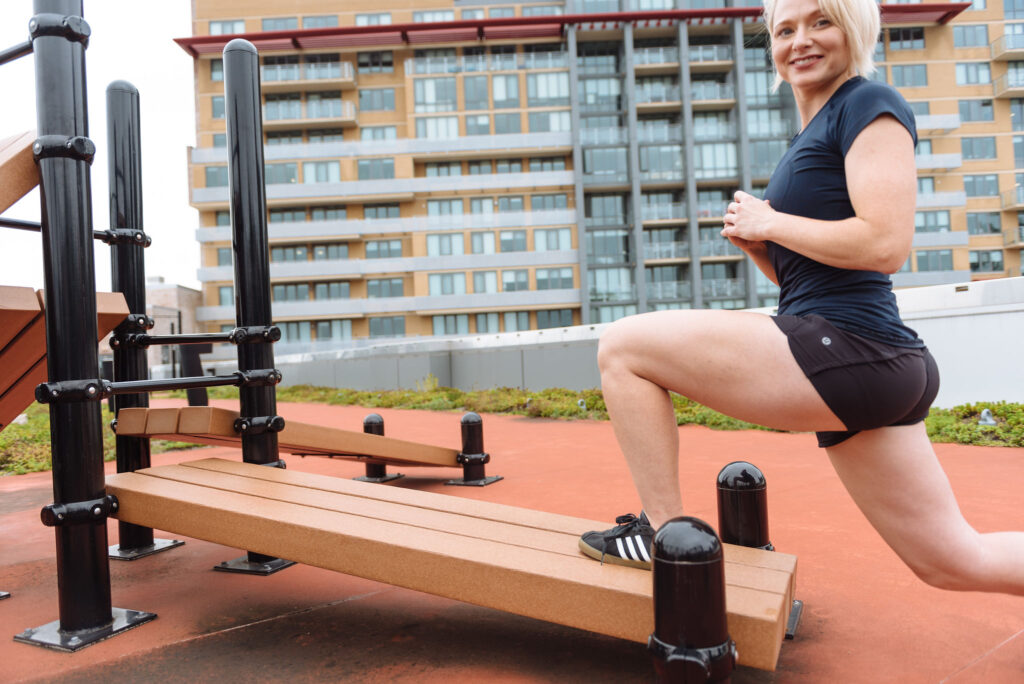
Strategy 3: Changing the body angles
Why would changing the body angles upgrade our home exercise? Changing the angle is all about individualized exercise selection, which is honestly a luxury for us during this pandemic period.
This is actually a big topic as it can create arguments about some very elementary beliefs about exercise. I’m going to keep it simple, changing the angle of your body can be devastating if you’re under a barbell with a lot of weight but in a bodyweight exercise, it can be exactly what is needed to make the exercise challenging in the right way.
For Squats and lunges adding a lift to the heels can help you get deeper in your squats/lunges and increase the metabolic demand of the exercises. This one is pretty simple, start by adding a single lift under each heel. This can be done with exercise mats or books. I would highly advise you to make sure it doesn’t slip on the surface you are exercising on.
Here’s an example of adding a lift to the heel and changing the knee/hip angles: Instagram video
Everyone has differences in their movement mechanics, meaning my squat looks different from your squat because our bodies are uniquely ours in how our hips, pelvis, and legs are structured.
So this advice can help many of us (me included) get deeper into our squat while helping our backs maintain a favorable angle while getting deep. To increase the metabolic demand of this exercise adds a slow tempo on each phase of the exercise as well as an isometric hold at the bottom.
Another example of this is changing the angle of the hip during lunges to create more demand for the posterior gluteal muscles. This is one of those anecdotes that would create an argument for some trainers that don’t know how to leave the ‘rules of exercise’ box and enter the sandbox that is the science of physics.
There is a concept called a ‘drop set’.
It’s used in bodybuilding to continue an exercise when fatigue starts to set in. It allows us to keep challenging the body while dropping off some of the resistance to challenge a new part or create the opportunity to work through fatigue in a safe way. When we understand the exercise fully, the mechanics and what muscles are being challenged, this can add bundles of fun and hard work to our bodyweight exercises.
On top of that, there is the science that supports that our body can perform better at exercises if we use the right cues. Which actually has something to do with the physics tips from above. I have recently re-discovered these incredible cueing principles related to how the brain develops skills and movements. Immediate changes are apparent and welcomed with my virtual training clients. This will be covered in upcoming podcast episodes that are rich in scientific findings and pieces of information that you can incorporate into your home exercise program.
The constant stream of headlines about ventilators and death is leaving something really big out of context: a strong body is one of the absolute best defenses against this novel virus. Stay true to your body and its need to build a strong foundation.
Your home exercise doesn’t have to suck.
Exercise is an opportunity to improve our body and mind while simultaneously investing in our future, how lucky are we to enjoy this?
There’s a million at home workouts popping up all over the place – but the market is NOT saturated for high quality, well-dictated fitness. Get started on streaming knowledge right from your device with my podcast, Think Fit. Be Fit. There is plenty of tips, stories, and insights from myself and expert guests to upgrade your current lifestyle.
If you’re serious about reprogramming your fitness lifestyle, if you’re looking to integrate these principles and apply to your current fitness routine, dig deep with Movement Pathways, my signature course that’s designed to help you change your mind-body connection through muscle activation forever. Each module will help take inventory in challenges you are facing and change the blueprint of your body’s wiring forever.
I’m always an advocate for listening to your body, moving mindfully, and ensuring a healing process from old injuries. Compounding the results of your efforts, see visible improvement in injuries, and don’t beat yourself up in the process!
